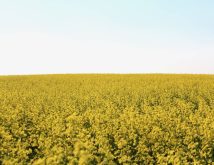Research from the University of Manitoba aims to get a better handle on the problem of volunteer canola in soybeans.
It begins with preventing canola from escaping the back of the combine the year before.
There’s already been a lot of work on volunteer canola issues and canola harvest loss. Rob Gulden, U of M researcher and acting associate head of the plant science department, says many variables affect loss rates and they are difficult to isolate.
Read Also

Manitoba boosts stake in cereals centre to $23.5 million
Premier Wab Kinew said the additional project funds will help ‘Trump-proof’ the provincial economy.
Why it matters: Faster-acting herbicides and optimized harvest techniques, such as proper combine speed and separator type, are crucial in reducing volunteer canola.
There are mechanical factors, including combine speed, settings and separator type. A farm’s chosen canola variety will also affect the amount of pod shatter.
Gulden found that harvest losses average about 5.9 per cent, but due to the higher yields of modern canola cultivars, those numbers can rise significantly and contribute more to the volunteer canola seed bank.
Combine settings play a big role in harvest loss, but manufacturer and type of combine (rotary or conventional) are less important.
Laura Schmidt, a production specialist with the Manitoba Pulse and Soybean Growers, said limiting canola harvest loss is “step one.”
“Just keeping the seeds in the pods longer so we can actually harvest them,” she said. “Make sure that you harvest as much of that crop as possible.”
In the short-term, that won’t stop canola seed already under the surface. The oilseed is resilient when it comes to dormancy, Schmidt noted.
Improving management now won’t necessarily stop future flushes. Canola is grown so frequently across the Prairies that the soil seed bank is constantly being restocked.
Light soil disturbance in fall, such as with a harrow, can limit the problem.
“It actually encourages a lot of those seeds to germinate in the fall, and then they won’t persist and they won’t become part of the seed bank,” Gulden said.
Herbicide tools
There can be significant crossover between the herbicide resistance profile of canola and that of soybeans if the producer isn’t careful about varieties. Doubling up Roundup Ready systems, for example, takes glyphosate off the table for control.
If there is no good herbicide option, canola is a highly competitive plant that holds its own against soybeans.
In 2017, Gulden and the Manitoba Pulse and Soybean Growers partnered to explore herbicide options against volunteer canola in Xtend soybeans.
Faster-acting modes of action were more effective at preventing soybean yield loss, especially under high volunteer canola pressure, the study found.
A variety of herbicides with different modes of action proved effective for in-crop management of volunteer canola in soybeans.
“Certainly, there are herbicides that can be used in crops or additional herbicides to manage volunteer canola within the soybean crop,” Gulden said.
Agronomy
Cultural control also plays a part in tamping down yield losses, Gulden said. Narrow rows work well.
“We’ve shown that making sure that we have good soybean plant stand density – 180,000 plants per acre or more – really reduces the need for herbicide to control wheat (and) volunteer canola,” he said.
Inter-row tillage can remove interval plants but does nothing to get rid of canola in the row.
In most cases, yield loss from volunteer canola is a manageable problem when the right tools are used, Gulden and Schmidt said.
















